The Three Most Indecent Myths About Germany “Hour Zero”
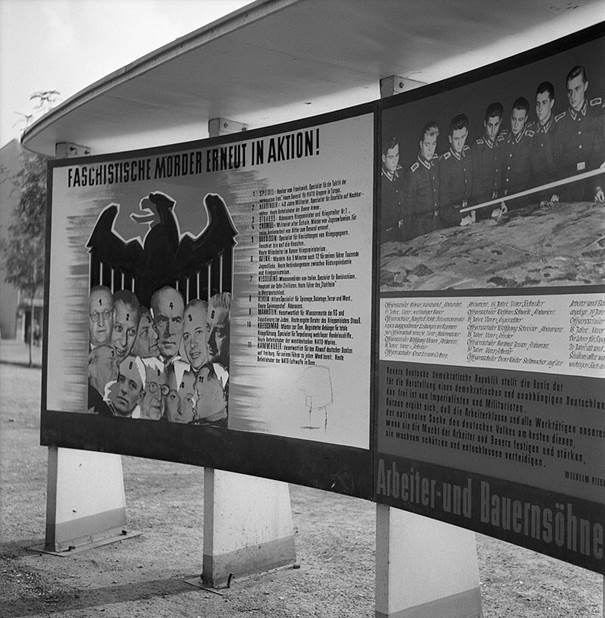
The idea that the end of World War II was a kind of “zero hour” for the Germans – a time of a radical break with the past and a new beginning – was widespread in the world as early as the 1950s. Year Zero” by the great Italian director Roberto Rossellini (I recommend watching it, filmed on real Berlin ruins in 1947).
The metaphor turned out to be very correct in the sense that in 1945 not only Hitler’s Germany, but also the old Imperial Germany in general finally ceased to exist. The Germans began building a new country on the ruins literally from scratch. And in a fairly short period of time, they were able to build an economically efficient and developed Western state, the Federal Republic of Germany. Since then, Germany has been held up as an example everywhere as a society that has gone through national repentance. It is claimed that it has largely become the spiritual source of the nation.
All this, of course, is good and wonderful, but for some reason it is completely forgotten (and many people do not know) that there are so many myths around this truly extraordinary phenomenon that it is time to make a collection of fairy tales out of them. And, what is most interesting, their main victims were primarily the Germans themselves (a kind word and a cat is pleased). I don’t have time to go into all the myths about the German “zero hour” (there are volumes about it), so I’ll only touch on three of the most common ones. Start!
1. The Myth of German Repentance
The most enduring of the myths, which many modern Germans openly abuse. We also adore it among our various “democrats” (with the letter M), who like to point their fingers at it, trying to shame the “incorrigible Soviets”. Needless to say, there was no such remorse at all.
How so?
Let’s reason…
Germany in 1945 was in many ways reminiscent of Russia during the Civil War, but with far greater destruction. The corpses of the once great medieval cities shone from all sides with ruins and a “lunar landscape”. The destruction of the German state and the structures responsible for the distribution of food led to severe famine, which was most severe in the winter of 1945/1946 and the winter of 1946/1947. At the same time, contrary to myths, they starved even in the most prosperous American zone of occupation (the calorie content of the rations issued there was only 1330 calories per day per person, what can we say for the rest?). Domestic agricultural production turned out to be clearly insufficient. The transportation system was in complete collapse. Taking into account the total halt of industrial production, the Germans in the most literal sense quickly slipped into the early Middle Ages. The country was swept by waves of refugees and “baggers” who roamed the countryside in search of food. The crime situation and mortality have increased significantly. Former “pure-blooded Aryans” were openly sold to soldiers of all armies for food and cigarettes. The situation was aggravated by millions of German refugees from the “eastern territories” (Prussia, the Czech Republic, etc.), to whom the West Germans were extremely hostile, as well as by many millions of so-called “displaced persons” (“Ostarbeiters”, concentration camp prisoners, collaborators, and former prisoners of war from all over Europe).
Needless to say, in such a situation the Germans did not think much of repentance, let alone of any reflection at all. All the political problems of the past have faded into the background. Moreover, the conviction that they were the victims in this situation began to grow rapidly (first Hitler, Hitler, T now the newcomers).
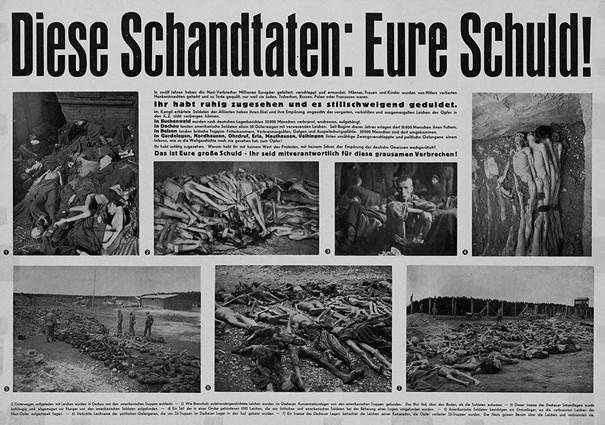
An American propaganda stand with photos from the concentration camps and the inscription: “These atrocities are your fault!”
As the British and Americans noted (based on their observations of their occupation zones), the Germans were openly hostile to all Allied occupation administrations without exception. In the eyes of the Germans, they were the source of all misery and half-starved existence. Rumors were actively spread among the common people that the Allies were deliberately starving the Germans and getting rid of them in every possible way. Protest moods grew and open resentment against those who fell on their heads was strengthened “injustice”. “The Nazis may have been bad, but we were human beings under them,” many reasoned at the time.
Echoes of those sentiments can easily be found among Germans today. The author of these lines just yesterday read a dialogue of several “civilian” Germans (under the article about the Battle of Kursk, and it was said that the Germans were almost victorious), in which they felt sorry for themselves in every possible way and could not understand why they were treated so badly after the war. “Attacked the Russians? So they attacked everyone on an equal footing with us. Did you see what they did in East Germany? Horror. They say 3 million Germans were massacred, barbarians.” What was striking was that not a single bastard under the article ever thought about the elementary: what happened at least to Kursk, and most importantly, where a significant part of its population went. Only about yourself, your loved ones. And this is a case in point. Even now, I repeat, it is very common among the German philistines, and even more so in those days.
At the same time, if immediately after the war the idea of oneself as victims grew out of a genuine, albeit frankly egoistic, self-pity, in the following years (decades!) it changed somewhat. Subsequent generations of Germans simply used it to hide the bad conscience of the nation and carefully relativize the crimes of their ancestors during the Third Reich. In fact, the above is an example of how they do it today. There is complete silence about the crimes in the USSR, about his sufferings at the end of the war (especially from the Reds) everywhere and everywhere (I am talking about the philistine level, not so among historians). Taking into account the reputation – business-like, developed, rich – this tactic works one hundred percent.
Although, strange as it may seem, from the point of view of modern historians, there was a positive moment in all this. The formation of the discourse of “German suffering and sacrifice” restrained the growth of revanchist and militarist sentiments in the immediate aftermath of World War II. In contrast to the First World War, which was perceived by a significant part of German society in the 1920s in a romantic and heroic light, which contributed to the strengthening of the cult of force, Nazis and other evil spirits.
Okay, but where is the repentance?
I guess now you understand that this is a pure myth?
2. The Myth of German “Re-Education”
Even in the midst of World War II, the Allies were faced with the acute question of what to do with the defeated Germany. At first, quite radical proposals were discussed, even to the point of forcibly turning the Germans into an agrarian nation, depriving them of industry and breaking them up into many small states. But in the end, we agreed that it was worth trying to “re-educate” and “democratize” them. However, no one really knew how to do it.
Already in our days, the myth of the so-called policy of “denazification” has become quite widespread, allegedly allowing the Germans to “re-educate” and return to the “family of civilized nations.” Moreover, they focus on its Western version. It is argued that the USSR pursued this policy in a narrowly primitive and repressive manner, only punishing the Nazis or their accomplices (and sometimes just political opponents who came to hand), at that time, How the Anglo-American allies were supposedly able to instill in the German people the principles of Western democracy that led them to success. The Germans themselves, by the way, are also very fond of this myth, especially since, for obvious reasons, immediately after the war, the Soviet people (as well as the Poles and Czechs) really treated them quite harshly (although not as harshly as they deserved). Here, too, there seems to be an element of resentment and hatred (we lost to the “inferior races” that we were supposed to conquer).
But what was the reality?
Did the Allies really turn out to be such great educators?

Soviet anti-fascist stand in the GDR
Well, of course, this is a myth. Moreover, the Americans and the British, as well as the Germans, believe in it equally deeply. It even unites them in some ways. But to easily refute it, let’s look at how the policy of so-called “denazification” took place in the Western occupation zones. Moreover, I will rely on the data of Western historians (they have analyzed this issue inside and out, although at the philistine level this myth is tenacious).
If everything is more or less clear with the individual punishment of individual Nazi criminals (some were hanged, some were imprisoned, some were recruited), then the mass “denazification” did not go so smoothly. First of all, the Allies began to fight against the German militaristic tradition: they banned the wearing of uniforms, military holidays, and even some paramilitary sports. All Nazi-militarist literature was wiped out of libraries. Almost all printed publications were closed. A mass dismissal of all members of the NSDAP began. The ensuing personnel shortage was so severe that the Allies quickly gave up on everything and allowed many former Nazis to return to administrative positions. To make it look more or less dignified and noble, all of them were recorded only as “fellow travelers”, allowing them to escape punishment. Most interestingly, the Germans themselves perceived this step as weakness and realized that the Allies could be easily manipulated.
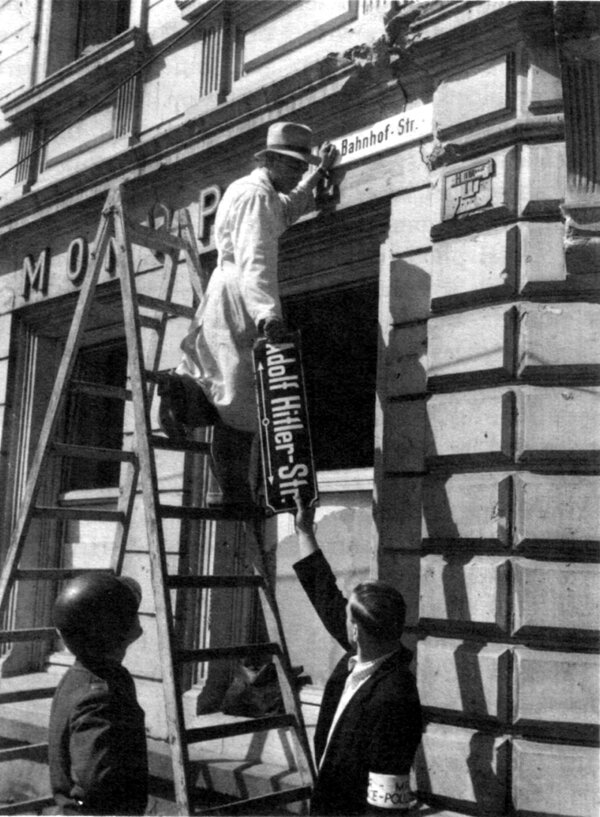
The street named after Adolf Hitler is renamed
The German manipulations were most fully manifested at the time of the mass survey of the population of the western zones. Surely you know that in 1945 the Americans decided to enumerate the entire population of the western occupation zones and developed a special questionnaire with 131 questions. By filling it out, the respondent fully disclosed his affiliation with the Nazi party and state bodies, past activities and views on life in general. These questionnaires were then reviewed by a special union commission, which eventually made a decision on whether the respondent belonged to one of five categories:
- Main criminals;
- Perpetrators;
- Less guilty;
- Fellow travelers;
- Innocent.
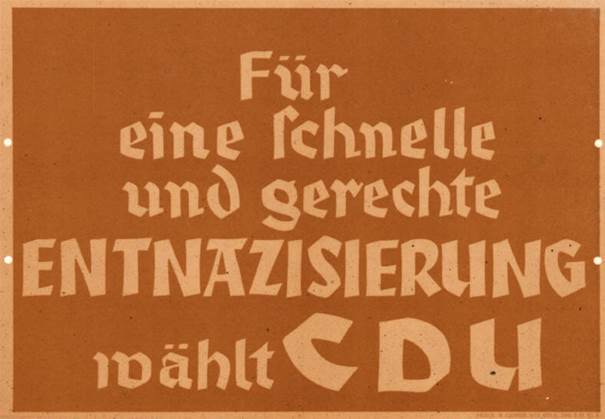
German election poster from 1947: “For quick and fair denazification, vote for the CDU” The poster looks faded, like the entire German democracy of that time
Depending on the category, punishment was also imposed (a prison term, a fine, or a ban on holding a particular position or profession).
In principle, the idea was good, but due to the scale, it soon quickly turned into a farce. The fact is that the union commissions were simply drowned in these questionnaires. To give you an idea, 13 million people filled them in the American zone alone. Therefore, soon their consideration began to be shifted to the local German administration, in which almost every second person had previously been a member of the NSDAP. Taking into account the solidarity and hatred for the newcomers, the German commissions (especially in the rural hinterland) made excessively lenient decisions, or even simply excused outright criminals and Nazis. Moreover, those members of the commission who still showed excessive zeal in considering the questionnaires were even threatened.
By the way, fake certificates of affiliation with the opposition to the NSDAP, which were nicknamed “persill certificates” (from the name of the detergent “Persil”, a type of reputation laundering), were especially popular at that time. For a fee, it was easy enough to get them. Moreover, they made it possible not only to avoid punishment, but also to appear as a “victim of the regime.” In this way, notorious Nazis were turned into victims.
Needless to say, this allied measure was quickly discredited in the eyes of the German population. It is not for nothing that in the early 1950’s Ernst von Salomon’s novel “The Questionnaire” was especially popular in Germany, in which he sarcastically answered 131 questions of a questionnaire. Taking into account his biography (in 1922, Salomon participated in the assassination of Foreign Minister Rathenau), as well as due to his own study by the Allies (the Americans knocked out his teeth during interrogation), the novel turned out to be “hot” and is still popular today.
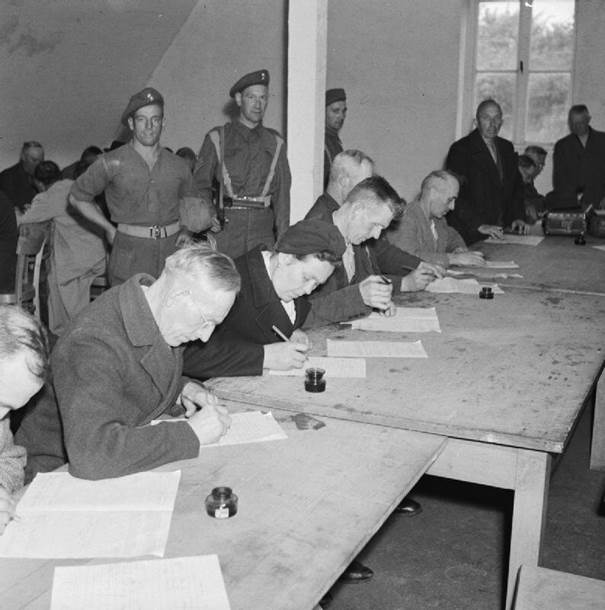
Germans fill out the famous denazification questionnaire in the British occupation zone
And with the onset of the Cold War, the Allies themselves quickly lost interest in the survey. After all, the Nazis tried to do everything to involve the Germans in their activities as widely as possible. The whole nation was in one way or another a member of some kind of Nazi organization, and therefore it was simply impossible to judge the entire population en masse. The Allies were no longer thinking so much about punishments as about integrating all Germans into the democratic system that was being built. Therefore, soon the general population began to be exempted from the questionnaire procedure, for example, all those born after 1919. Punishments were also gradually mitigated.
As a result, 3.6 million questionnaires were considered in two years: 1,667 people fell into the category of former criminals, 23,000 were guilty, and 150,000 were less guilty. In total, less than 5% of the population is combined. Moreover, many of them later managed to achieve revision and transfer to the categories of “fellow travelers” and “innocent”. That was the end of the “re-education”.
Today, even Western historians widely admit that the program of “denazification” and “re-education” then failed. Although others see advantages in it. For example, it made the Nazi regime look illegitimate and criminal in the eyes of Germans, something to be ashamed of and shunned of. Even his ardent supporters were forced to retreat into the shadows, hide and remain silent. But on a philistine level, I repeat, both Americans and Germans believe that it was then that they merged into one in Western ecstasy. Some of our “democratizers” believe in this with them.
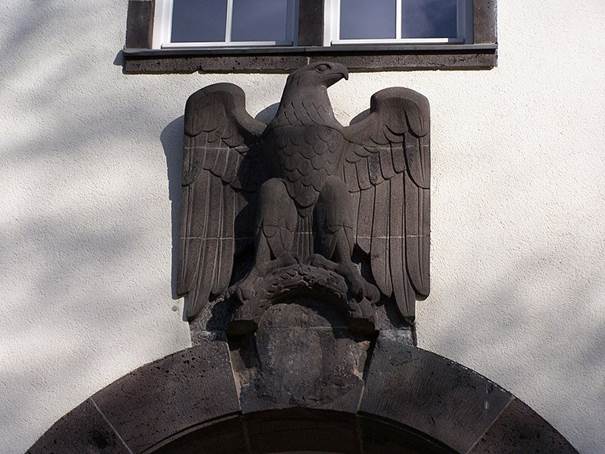
Denazification in action. The eagle over the entrance to the University of Darmstadt was left and the swastika was “denazified”. A good metaphor for the half-heartedness of the process
3. The Myth of the German “Overcoming the Past”
The Germans were able to understand their own past, condemn it, recognize their collective responsibility, and only for this reason were they able to build a modern democratic state, another widespread and rather harmful myth that lives in the world public consciousness.
In fact, it was exactly the opposite: first, stable state and economic structures were built, there was a manifold increase in the standard of living, and only then did the Germans begin to gradually comprehend their past. This process has dragged on for many decades, and it has not been completed even today.
And what can go far, if German historians began to argue about the criminal nature of the Wehrmacht only… in 1994. Before that, there was a consensus in German society that Hitler and the SS committed crimes, and “ordinary” soldiers and officers were not involved in anything. Moreover, many even considered (and still do!) themselves… Victims. For example, Stalingrad.
This is the reason why the Germans did not reflect on the date of June 22, 1941 at all. In Germany, it is almost never widely mentioned and is not repented of on this day (except for the usual words of the German ambassadors to Russia, Belarus and Ukraine).
The Germans are also absolutely indifferent to the siege of Leningrad. It was only in 2004 that the German historian Hanzenmüller defended his doctoral dissertation, proving that it was a deliberate genocide, but few people noticed this. In the late 1970s, a professor at a prestigious German university was fired for publishing a book called They Are Not Our Comrades., in which he told on the documents about the brutal extermination of 3.3 million Soviet prisoners of war by representatives of the Wehrmacht. I’m talking about Christian Streit, of course.
That is why (for me personally) the words of some of our leaders that “we must follow the example of the Germans” always sound blasphemous.
In the 1950s, the notorious Hannah Arendt wrote after a visit to Germany:
Nowhere is horror and destruction so little evoked by feelings and words as in Germany itself. A general lack of emotion, an obvious callousness disguised as cheap sentimentality, is the most visible outward symptom of a deep-seated, stubborn, and at times malicious reluctance to see and understand what has really happened. This escape from reality is an escape from responsibility.

Hannah Arendt
Indeed, in the early Federal Republic of Germany, the Second World War was discussed only in the sense that the Germans suffered at the fronts, under bombs and from the actions of the Soviet-Western “occupiers”. At most, Hitler and the Nazis were blamed for these tragedies. And even then, they were angry with them more for deceiving and not keeping their promises than for what they had experienced. Moreover, even in the 1950s, according to polls conducted by Western statisticians, many Germans called the Third Reich the best period of their lives.
The Germans also had a negative attitude towards the Nuremberg Trials, believing that it was a classic “court of winners.” They were also infuriated by propaganda measures for denazification, when, for example, the Allies forced them to watch films about the horrors in concentration camps. And such “troublemakers” as the philosopher Jaspers and the writer Thomas Mann, who called for national repentance, were almost spat upon.
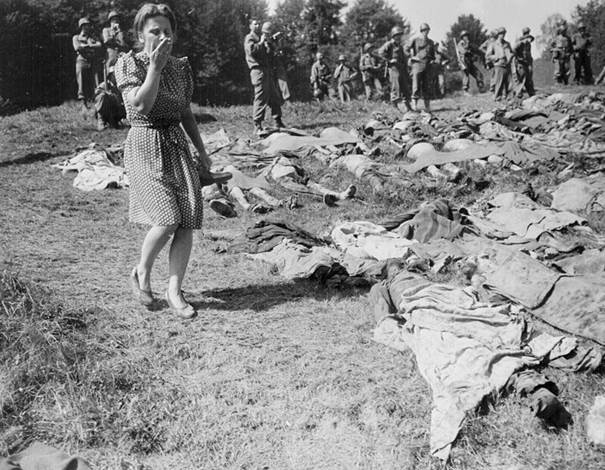
Despite the fact that the Americans took German citizens to concentration camps, this did not affect their attitude to their past at all
In general, in the era of Adenauer, it was decided to leave “all the bad” in the past and just silently move forward. An unspoken agreement was even made between the new “democrats” and the former militarists and Nazis: you do not interfere with our state building and show loyalty, and we provide you with comfort, peace and honor.
In 1951, the law “On the Completion of Denazification” was adopted in the Federal Republic of Germany. Many of those who received a ban on the profession were amnestied. As a result, by the mid-1950s, former Nazis began to dominate the German authorities. According to modern historians, by the end of the 1950s, 60% of the heads of all ministries and deportations of the Federal Republic of Germany were the heads of all ministries and deportations. In the judicial system, their number reached 80%.
At the same time, the Adenauer government (and all subsequent ones) continued to publicly condemn the crimes of the Third Reich. As a result, a paradoxical image of “crimes without criminals and Nazism without Nazis” (a quote from one historian) has emerged. However, realizing the danger of the various veterans’ organizations that had played a sinister role in the Weimar Republic, many former Nazi officers were forcibly integrated into West German “democratic life.” Like, for example, Field Marshal Manstein was released after 7 years in prison. But there was still no question of repentance.
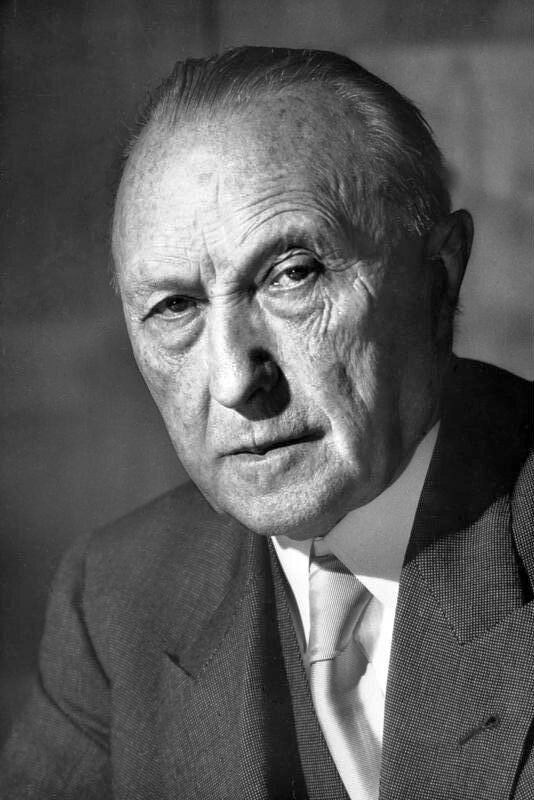
Konrad Adenauer
The so-called “communist danger” also rendered great “help” to the Germans in blurring the past. Once on the front lines of the Cold War, they began to openly speculate on the closed and alienated nature of our country. They say that what can be taken from these wild communists, and if we committed crimes there, then there is nothing extraordinary in them. At the same time, the West was ready to support such a line of behavior. Indeed, the main thing is “transatlantic unity”, and not picking at German crimes against the USSR. And the next generations of Germans already perceived the FRG as an organic part of the “free West” opposing the “totalitarian East.” In general, the Germans of that time were characterized by apoliticalness, a desire to withdraw into private life, and an orientation towards personal success. Like their fathers, there was no desire to reflect (although there were some very interesting exceptions).
And if it had not been for the Holocaust, it is likely that German society would never have come to repentance for the Nazi past. It was with the controversy over the extermination of the Jews that the rethinking of the entire German route began. However, this alone took decades. For the same time, the debate about guilt before Poland and the USSR continues. Or rather, not even controversy, here, to the credit of German historians, everything is unambiguous. But the trouble is that they do not have any similar programs (as in the case of the Holocaust) to inculcate knowledge of the criminal German war in broad German strata, starting from school. Although it seems that textbooks write about the Second World War, but it is so vague and fluent that only the suffering of German soldiers at Stalingrad and the Jewish girl Anne Frank, who died in a concentration camp, remain in the memory. All.
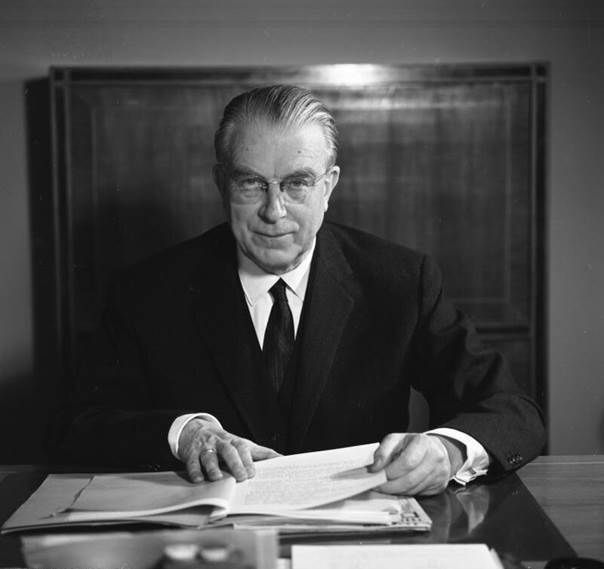
A typical example of the “success” of denazification. In the photo, Hans Globke is Adenauer’s secretary of state. Globke was instrumental in drafting the anti-Semitic Nuremberg Race Laws, which were the first step in the Holocaust.
Recently, I wrote that the Poles were accused of the Germans for not telling young people in Germany about the crimes in Poland. And in general, they are trying to protect their offspring from talk of German crimes “in the East.” Our journalists also raised the topic of German textbooks. Do you know what they were told? They say that school curricula are designed in such a way as not to strain or shock students, in order to teach them obedience to the law and goodness. How!
Taking into account the current aggravation of our relations, I personally expect a new surge in the relativization of German crimes. I can already see it on a layman’s level, even on serious forums. And if we take into account that modern Germany has the Baltic States and Ukraine as allies… But, that’s a topic for another article.
This is how the three most important myths about German historical repentance look like in a nutshell.
